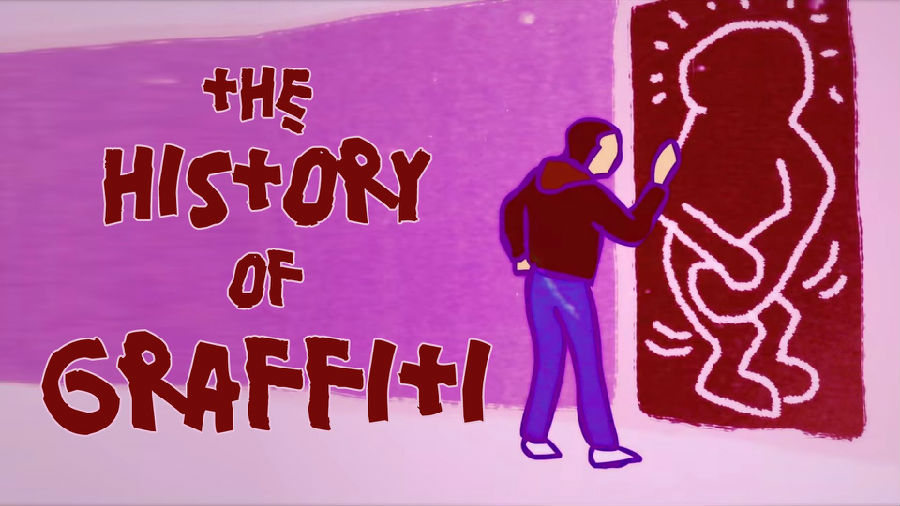(单词翻译:单击)
Spray-painted subway cars, tagged bridges, mural-covered walls.
喷满颜料的地铁 写满文字的桥梁 绘满图案的墙壁
Graffiti pops up boldly throughout our cities.
涂鸦在我们的城市中陡然盛行
It can make statements about identity, art, empowerment, and politics, while simultaneously being associated with destruction.
它可以展示人们对身份 艺术 权利 政治的看法而同时又被认为是一种破坏活动
And, it turns out, it's nothing new.
这其实并不是什么新鲜事
Graffiti, or the act of writing or scribbling on public property, has been around for thousands of years.
涂鸦或者在公共物品上乱写乱画的行为已经存在数千年了
And across that span of time, it's raised the same questions we debate now: Is it art? Is it vandalism?
随着时间的推移 同样备受争议的问题产生了 这是一种艺术 还是一种肆意破坏公物的行为
In the 1st century BCE, Romans regularly inscribed messages on public walls,
公元前1世纪 罗马人就常常在公共墙壁上刻写信息

while oceans away, Mayans were prolifically scratching drawings onto their surfaces.
而在大洋彼岸玛雅人也经常在墙面上画画
And it wasn't always a subversive act.
涂鸦并不总是一种破坏行为
In Pompeii, ordinary citizens regularly marked public walls with magic spells, prose about unrequited love, political campaign slogans,
庞培古城里的普通民众也常在公共墙面上刻写咒语 单相思的情诗 政治运动口号
and even messages to champion their favorite gladiators.
甚至是留言给他们喜欢的角斗士加油
Some, including the Greek philosopher Plutarch, pushed back, deeming graffiti ridiculous and pointless.
以希腊哲学家普鲁塔卡为代表的一些人 反对涂鸦认为这是荒谬和毫无意义的
But it wasn't until the 5th century that the roots of the modern concept of vandalism were planted.
不过 直到公元5世纪才出现了蓄意破坏公物这一现代概念
At that time, a barbaric tribe known as the Vandals swept through Rome, pillaging and destroying the city.
那时 一个叫做汪达尔的野蛮部落侵袭了罗马 一路劫掠 破坏罗马城
But it wasn't until centuries later that the term vandalism was actually coined in an outcry against the defacing of art during the French Revolution.
几个世纪后 蓄意破坏公物一词才正式出现 用于反对法国文艺复兴时期毁坏艺术品的行为
And as graffiti became increasingly associated with deliberate rebellion and provocativeness, it took on its vandalist label.
而随着涂鸦 和蓄意反叛与挑衅之间的联系愈发紧密它也被贴上了蓄意破坏的标签
That's part of the reason why, today, many graffiti artists stay underground.
那就是现在很多艺术家仍然不敢明目张胆地出现的原因
Some assume alternate identities to avoid retribution, while others do so to establish comradery and make claim to territory.
涂鸦者们改名换姓 有的是为了逃避责罚 有的则是为了联立同盟 划分活动范围
Beginning with the tags of the 1960s, a novel overlap of celebrity and anonymity hit the streets of New York City and Philadelphia.
从20世纪60年代开始 一种新的名人和匿名画家共存的形式在纽约和费城街头盛行
Taggers used coded labels to trace their movements around cities while often alluding to their origins.
涂鸦者在城市各处的作品上留下独有的标签来暗示自己的身份
And the very illegality of graffiti-making that forced it into the shadows also added to its intrigue and growing base of followers.
正式由于涂鸦的非法性使得其不得不隐藏在暗处这一点更加增加了涂鸦的神秘感 从而带来了越来越多的追随者
The question of space and ownership is central to graffiti's history.
空间和所有权问题是涂鸦史上的核心问题
Its contemporary evolution has gone hand in hand with counterculture scenes.
当代涂鸦与反主流文化潮流并驾齐驱
While these movements raised their anti-establishment voices, graffiti artists likewise challenged established boundaries of public property.
后者吹响了反建制的号角 涂鸦者同样也挑战了公共财产的传统底线
They reclaimed subway cars, billboards, and even once went so far as to paint an elephant in the city zoo.
他们的画布扩展到地铁 和公告牌 甚至动物园里的大象
Political movements, too, have used wall writing to visually spread their messages.
政治活动也能利用墙上涂鸦来大胆地传播他们的信息。
During World War II, both the Nazi Party and resistance groups covered walls with propaganda.
二战期间 纳粹党和抵抗组织都在墙壁上写满了他们的宣传语
And the Berlin Wall's one-sided graffiti can be seen as a striking symbol of repression versus relatively unrestricted public access.
而柏林墙的单边涂鸦使其鲜明区别于自由开放的普通出入口成为了压迫的象征
As the counterculture movements associated with graffiti become mainstream, does graffiti, too, become accepted?
随着跟涂鸦有着紧密联系的非主流文化运动成为主流 涂鸦也随即为人们所接受
Since the creation of so-called graffiti unions in the 1970s and the admission of select graffiti artists into art galleries a decade later,graffiti has straddled the line between being outside and inside the mainstream.
一直以来 涂鸦徘徊于主流的边缘
And the appropriation of graffiti styles by marketers and typographers has made this definition even more unclear.
而市场营销和印刷厂商对涂鸦风格的擅用则使得涂鸦的定位更加模糊
The once unlikely partnerships of graffiti artists with traditional museums and brands,
曾经看似遥不可及的传统博物馆和品牌也开始向涂鸦艺术家敞开大门 寻求合作
have brought these artists out of the underground and into the spotlight.
这也将涂鸦艺术家带离暗处领到聚光灯下
Although graffiti is linked to destruction, it's also a medium of unrestricted artistic expression.
虽然人们一想到涂鸦就会想到破坏这个词 但是它也是一种随意尽心的艺术表达形式
Today, the debate about the boundary between defacing and beautifying continues.
现在关于破坏和美化的分界点的问题人们仍然在争论不休
Meanwhile, graffiti artists challenge common consensus about the value of art and the degree to which any space can be owned.
同时 涂鸦者也在挑战着人们对艺术价值和空间所有权的传统认识
Whether spraying, scrawling, or scratching, graffiti brings these questions of ownership, art, and acceptability to the surface.
无论是以喷 乱涂乱画 还是刮的形式出现 涂鸦都将所有权 艺术和可接受性这些话题呈现在人们面前


